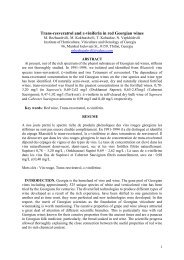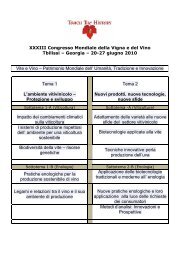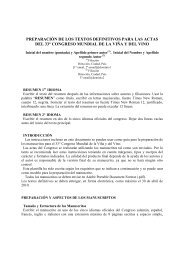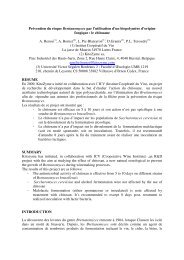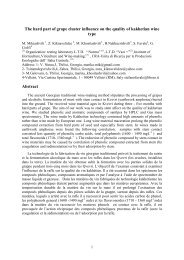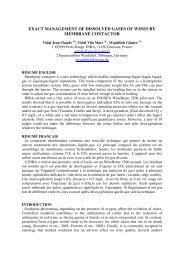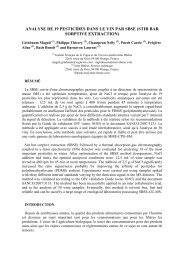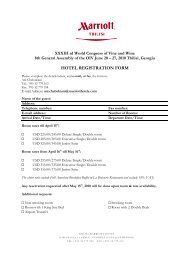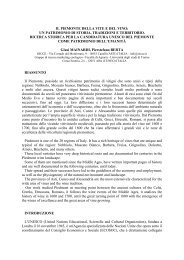P.II.52- narchenebi.pdf - Oiv2010.ge
P.II.52- narchenebi.pdf - Oiv2010.ge
P.II.52- narchenebi.pdf - Oiv2010.ge
You also want an ePaper? Increase the reach of your titles
YUMPU automatically turns print PDFs into web optimized ePapers that Google loves.
must released from the mud after settling and alcoholic distillation, as well as in the course of<br />
wine maturation; The mud received as a result of pasteurization, sulphatization, cooling and<br />
production of the grape juice; Grains (distillery refuse) - as a result of distillation of the wine<br />
material.<br />
A high content of the free fat acids and glycerine is detected in the grape branch and seed,<br />
while in their extracts a number of biologically active substances are identified (Mudziri, 1988)<br />
The grape seed contains 22-56% of the total poly-phenols, 28-58% of leukoanthocytes, 67-<br />
68% catekhines and an important volumes of the gal and the coffee acids (Ribero-Gayon, et al.,<br />
1981)<br />
The issues related to a complex processing of the wine secondary waste and a relevant<br />
application thereof, has not been still studied-in duly. Such the complex processing of these<br />
materials can make the wine production ecologically safe.<br />
MATERIALS AND METHODS<br />
A purpose of the study was to receive the biologically active compounds from the<br />
secondary products (grape rod, branch, wine mud, grape grain) and their use in different fields of<br />
the National Economy.<br />
A task of the study was to determine a content of nitrogenous compounds in the secondary<br />
wine products and to establish their biological quality; To develop the means of separation from<br />
the secondary wastes the biologically active compounds and their products and the use thereof.<br />
The secondary grape- and wine products, namely – the wine mud and the grape grain<br />
(distillery refuse) were selected as the objects of the study. Besides, the alcohol was isolated<br />
from the fermented grape branch. Thereafter, these secondary products underwent a process of<br />
drying and segregation and the biologically active substances were extracted from them and<br />
concentrated.<br />
A thickened mass of the hydrolyse received by use of the fermentation apparatus for<br />
malising the processed wine mud, is a protein-vitamin concentrate containing up to 50% soluble<br />
proteins and considerable amounts of amino-acids and vitamins. According to the above<br />
mentioned results, it is possible to use the said protein-vitamin concentrate as a stimulator for<br />
plants growing.<br />
For receiving the alcohol and the tartaric acid’s lime from the liquid mud, we conducted the<br />
distillation of the same and extracted the grains from the tartaric acid-containing compounds.<br />
As to the paste-like mud, it was first diluted in the water and mixed intensively, while the<br />
received liquid mass was used for distillation of the alcohol and extraction of the tartaric acid’s<br />
compounds.<br />
The wine mud of the “Rkatsiteli” grape sort being fully fermented, was used by us as the<br />
object of study. We have researched the wine mud until and after distillation of the alcohol and<br />
sedimentation of the tartaric acid’s salts. In order to separate the protein fractions from the yeast<br />
cells it became necessary to disintegrate the cell membrane through acidic hydrolyse of the wine<br />
mud. The protein-containing components were determined by a method (Pavlenko et al. 1968),<br />
during which we received the proteins soluble in water, salt, alcohol, and alkaline, while their<br />
quantitative in single fractions of the protein were determined by the Gartre method, and the<br />
total nitrogen content – by the Keldal method.<br />
RESULTS AND DISCUSSION<br />
As revealed, the wine mud after distillation of alcohol and sedimentation of the tartaric<br />
acid’s salts, the wine mud contains the protein substances with a total quantity up to 23%.<br />
We have researched also the grape seed’s nitrogenous substances, namely – the proteincontaining<br />
and not containing nitrogen, globulins, albumins, amino-acids. The seeds of the grape



